What is Pollen?
- Pollen is a fine or coarse powder consisting of microgametophytes, which are crucial for the reproduction of flowering plants and conifers. It serves as the carrier of male gametes, or sperm cells, essential for the fertilization process.
- Each pollen grain encompasses the male reproductive cells required for successful fertilization. When pollen grains are transferred from the male structures of a plant to the female structures, fertilization can occur, leading to seed production and plant propagation.
- The scientific discipline dedicated to the study of pollen grains, both living and fossilized, is known as palynology. This field explores the properties, distribution, and ecological significance of pollen, contributing valuable insights into plant reproduction and the historical climate and vegetation of different regions.
- Therefore, understanding pollen and its functions is fundamental to comprehending plant reproduction and the broader ecological interactions within various environments.
What are Pollen Grain?
- Pollen grains are microscopic structures produced by the male reproductive organs of flowering plants, specifically the anthers. These grains play a crucial role in the fertilization process and sexual reproduction of plants.
- Pollen grains typically appear as fine dust and are dispersed through various mechanisms, including wind, water, and insects, to reach the female reproductive structures of plants. Upon reaching the stigma of a flower, the pollen grain germinates, forming a pollen tube. This tube grows down the style and delivers sperm cells to the ovule for fertilization.
- Pollen grains exhibit diverse shapes and sizes, varying according to the plant species from which they originate. Inside the pollen grain, the cytoplasm contains two main types of cells: the tube cell and the generative cell. The tube cell develops into the pollen tube, while the generative cell divides to form the sperm nuclei essential for fertilization.
- Therefore, understanding pollen grains is fundamental to comprehending plant reproduction. The scientific study of pollen, both living and fossilized, is referred to as palynology, which provides insights into plant biology, ecology, and historical climate changes.
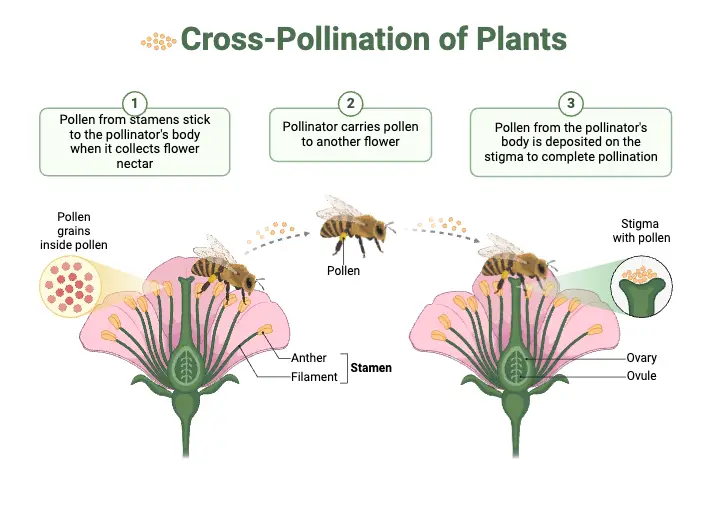
Characteristics of Pollen Grain
- Size:
- Pollen grains exhibit significant variation in size, measured in micrometers (µm), with 1 mm equaling 1000 µm.
- Sizes range from as small as 6 µm in species like forget-me-nots to as large as 100 µm in birch trees.
- Most pollen grains measure between 10 and 70 µm in diameter.
- The size of pollen grains often correlates with their dispersal method. Smaller grains are typically wind-dispersed, while larger grains are usually carried by animals or water.
- Shape:
- Pollen grains can be spherical, ovoid, triangular, or disc-shaped.
- They may also exhibit variations such as elongated or flattened forms.
- Specific shapes can aid in the classification of pollen at the family, genus, and sometimes species levels.
- Apertures:
- Apertures are openings in the pollen grain wall through which male gametes exit during pollination.
- There are two primary types of apertures:
- Pores: Circular openings.
- Colpi: Elongated furrows.
- A single pollen grain may have multiple apertures, and both pores and colpi may be present.
- Surface Texture:
- The surface of pollen grains is highly variable and often plays a role in species-specific recognition.
- Textures are categorized into several types:
- Psilate: Smooth, without any surface markings.
- Reticulate: Net-like patterns.
- Striate: Parallel lines.
- Rugulate: Rough, irregular patterns.
- Verrucate: Bumpy surfaces.
Structure of Pollen Grain
The structure of pollen grains, also known as microspores, is a fundamental aspect of plant reproduction and offers insights into evolutionary and taxonomic relationships among plant species. Pollen grains are minute, unicellular structures with complex features that can be categorized into several key aspects: polarity, symmetry, apertures, size and shape, exine stratification, and exine sculpturing.

- Polarity:
- Tetrad Formation: Pollen grains are typically formed in tetrads, clusters of four grains originating from a single mother cell. This tetrad stage is crucial for understanding certain morphological traits of the exine.
- Poles and Axis: Within a tetrad, the pollen grain’s orientation is defined by its poles. The proximal pole is oriented towards the center of the tetrad, while the distal pole faces outward. The polar axis is perpendicular to the distal pole at the apex and the proximal pole at the base.
- Isopolar vs. Heteropolar: Pollen grains can be isopolar, with similar faces, or heteropolar, with differing faces. Heteropolar grains have one face with an aperture and the other without.
- Apertures:
- Types of Apertures: Pollen grains may have apertures, which are openings in the exine. These can be elongate (colpate) or circular (porate). Apertures can also be simple, where outer and inner surfaces match, or compound, where they differ.
- Colporate and Porate Apertures: In colporate apertures, the outer part (ectocolpium) is elongated, while the inner surface (endocolpium) can be circular or elongated in various directions. The margin of the aperture can be thin (tenuimarginate) or thick (crassimarginate). Some apertures may also have dome-like protrusions (asphides) and varied end forms (blunt or pointed).
- Size and Shape:
- Size Variation: Pollen grains vary significantly in size, ranging from 5 micrometers (µm) to 200 µm, as observed in the Cucurbitaceae family.
- Shape: The shape of pollen grains can be diverse. They may be flat (peroblate), elongated (perprolate), or take other standard forms depending on the plant species.
- Exine Stratification:
- Layers: The pollen wall consists of two main layers: the outer exine and the inner intine. The intine is thin and pectocellulosic, often destroyed during acetolysis.
- Exine Structure: The exine has two principal layers:
- Sexine: The outer sculptured layer, composed of columellae (upright rod-like elements) and a roof-like layer called the tectum.
- Nexine: The inner, non-sculptured layer beneath the sexine.
- Types of Exine:
- Tectate: Contains a continuous tectum that covers the columellae and nexine.
- Semitectate: Features a perforated tectum.
- Intectate (or Atectate): Lacks a tectum, consisting only of nexine and columellae.
- Exine Sculpturing:
- Types of Sculpturing: The external surface details of the pollen wall, known as sculpturing, vary widely:
- Psilate: Smooth surface.
- Faveolate: Pitted texture.
- Fossulate: Grooved appearance.
- Scabrate: Fine projections.
- Verrucate: Warty texture.
- Baculate: Rod-like elements.
- Gemmate: Sessile pillars.
- Pilate: Rod-like elements with swollen tips.
- Echinate: Spiny projections.
- Punctate: Minute perforations.
- Reticulate: Open network of elements.
- Rugulate: Elongated elements arranged tangentially.
- Types of Sculpturing: The external surface details of the pollen wall, known as sculpturing, vary widely:
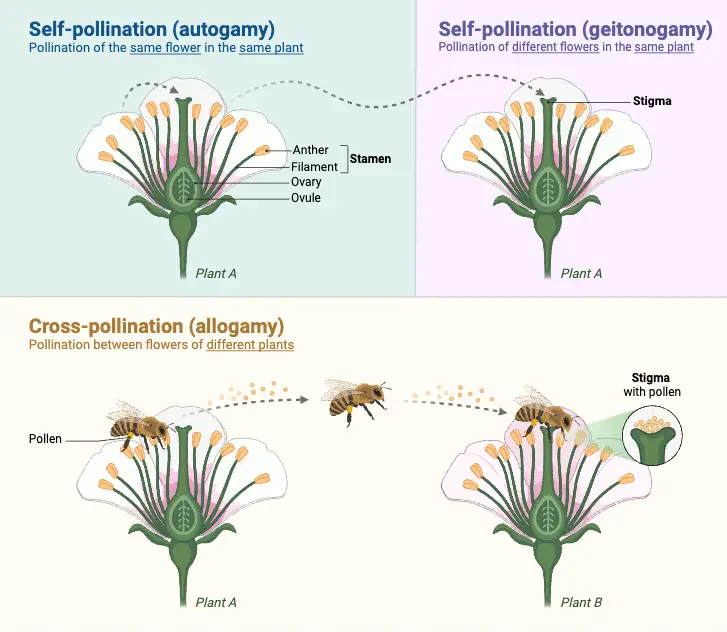

Types of Pollen Grains
Pollen grains exhibit considerable diversity in their morphology, which can be classified based on several key characteristics: shape, size, orientation of furrows, and surface texture. Understanding these classifications provides insight into the variety of pollen forms found in different plant species and aids in applications such as plant identification and allergen research.
1. Classification Based on Shape
Pollen grains can be categorized according to their shape into several distinct forms:
- Ovoid: Egg-shaped, with a more elongated form.
- Spherical: Round and symmetrical in all directions.
- Triangular: Three-cornered, often exhibiting triangular patterns on the surface.
- Disc-shaped: Flat and circular, resembling a disc.
Each shape influences the pollen’s aerodynamic properties and interaction with pollinators or dispersal mechanisms.
2. Classification Based on Size
Pollen grain size varies widely and is an important distinguishing feature:
- Range: Typically, pollen grains measure between 6 micrometers and 100 micrometers in diameter.
- Common Size: Most pollen grains fall within the 10 to 70 micrometer range.
The size of pollen grains can affect their dispersal capabilities and their interaction with the environment.
3. Classification Based on Orientation of Furrows
The orientation and configuration of furrows on pollen grains provide a means of classification:
- Sulcate Pollen: Characterized by a furrow running across the center.
- Monosulcate: Features a single furrow.
- Bisulcate: Contains two furrows.
- Polysulcate: Exhibits multiple furrows.
- Colpate Pollen: Exhibits a furrow running from a position other than the center.
- Syncopate: Shows two or more fused ends.
- Polysorbate: Lacks fused ends and presents multiple separate furrows.
These classifications are derived from the orientation of the furrow relative to the original tetrads from microspores and are crucial for identifying pollen under microscopic examination.
4. Classification Based on Surface Texture
Surface texture is another distinguishing characteristic and includes:
- Psilate: Smooth surface, lacking any distinct patterns.
- Reticulate: Surface with a net-like appearance, often showing a network of interconnected lines.
- Striated: Exhibits rough, parallel lines or patterns.
- Rugulate: Features an irregular, wrinkled pattern.
- Verrucate: Surface covered with bumps or protrusions.
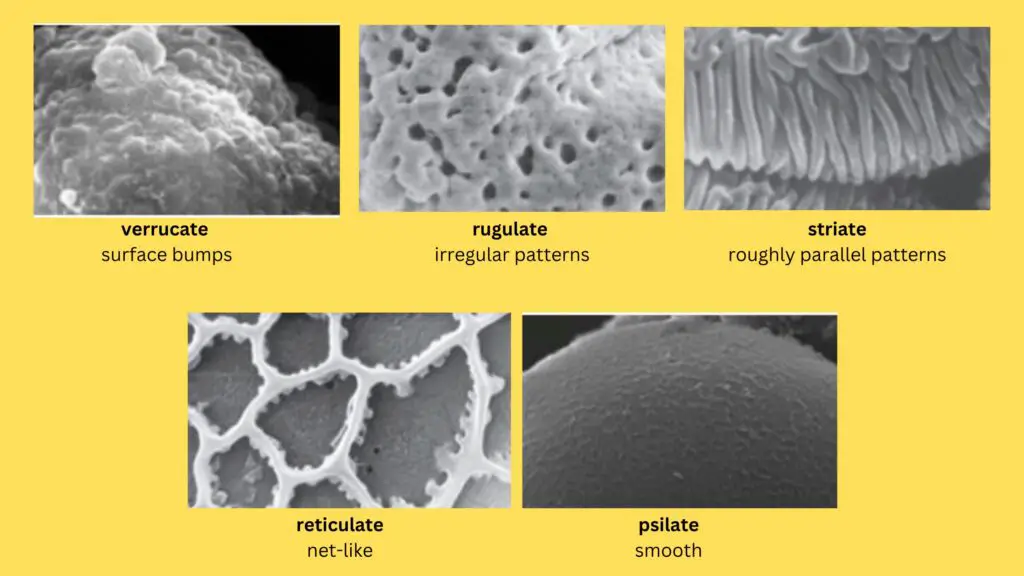
The surface texture impacts the pollen’s interaction with pollinators and its dispersal through the air.
Morphology of some pollen grains
Morphology of Some Pollen Grains
- Pollen Grains of Caesalpinia pulcherrima:
- Shape: Spheroidal.
- Size: Ranges between 77 and 90 µm in diameter.
- Apertures: Characterized by three zonaperturate ends of pseudocolpi united at the poles, creating a synpseudocolpate condition. The endoaperture measures 9.8 µm by 5.6 µm.
- Exine: Relatively thick, ranging from 4 to 6 µm, thinner at the pseudocolpium region and tapering around the aperture. The exine is thicker overall and narrows at the aperture edges.
- Surface Texture: The ectine surface exhibits a gradation of patterns, including areolate, rugulate, and reticulate on the mesocolpium, with a psilate pattern in the pseudocolpium.
- Pollen Grains of Althaea rosea:
- Shape: Spheroidal.
- Size: Diameter ranges from 130 to 140 µm.
- Apertures: Panporate.
- Exine: Approximately 7 µm thick and spinate. The columellate layer (ectine) is thinner compared to the endine.
- Surface Features: Spines are dimorphic, with longer spines reaching about 20-21 µm and shorter ones about 5-6 µm. The ends of all spines are pointed, and a basal cushion is not formed.
- Pollen Grains of Carica papaya:
- Shape: Subprolate or occasionally spheroidal.
- Size: Ranges from 32-35 µm by 28-32 µm.
- Apertures: 3-zonicolporate, with slightly constricted ectocolpium margins and ends that are either rounded or pointed.
- Exine: Approximately 2 µm thick, with the ectine nearly as thick as the entine.
- Surface Features: The ectocolpium exhibits a slight constriction in the middle, and the endocolpium is elongate, measuring 3 µm by 7 µm, with lateral ends slightly rounded.



Development of Pollen
Pollen grain development occurs within the anthers of flowering plants and follows a highly structured process. Although there is some variation among plant species, the fundamental stages of pollen development are broadly similar. Here is a detailed description of the development of pollen grains:
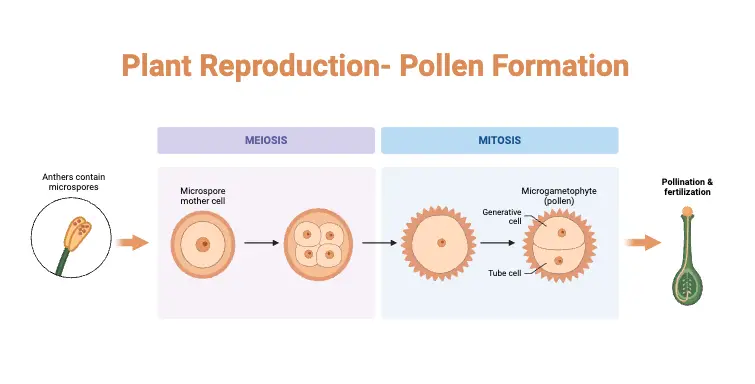
- Initial Stage:
- Young Anther: The young anther begins as a mass of homogeneous meristematic cells enclosed by the epidermis.
- Differentiation of Archesporial Cells: Four groups of archesporial cells develop in the hypodermal layer, corresponding to the four microsporangia. These cells divide periclinally to form a primary parietal layer and a primary sporogenous layer.
- Formation of Wall Layers:
- Parietal Layer: The primary parietal layer gives rise to the wall layers of the anther, including the epidermis, endothecium, middle layer, and tapetum, through successive periclinal and anticlinal divisions.
- Sporogenous Layer: The primary sporogenous layer differentiates into microspore mother cells (meiocytes).
- Wall Layer Differentiation:
- Endothecium: Develops radial thickenings.
- Middle Layer: Becomes flattened and eventually degenerates.
- Tapetum: Becomes a prominent, specialized layer, often multinucleate and polyploid. It can either remain in a parietal position until degeneration (secretory type) or break down to form a plasmodium that penetrates the anther locule (invasive or amoeboid type).
- Microspore Development:
- Meiosis: Microspore mother cells undergo meiosis to form tetrads of microspores. The wall formation during meiosis can be either successive (developing after each nuclear division) or simultaneous (developing after the second nuclear division), with monocots typically showing successive wall formation and dicots simultaneous.
- Separation of Microspores: In some plants, microspore tetrads remain together and are dispersed as polyads, while in others, they remain as aggregates called pollinia.
- Microspore Enlargement and Division:
- Enlargement: The microspores, after release from the tetrad, enlarge and prepare for division. A large vacuole forms, and the nucleus migrates to the periphery.
- Asymmetric Division: The microspore undergoes asymmetric division to form a vegetative cell and a generative cell. This division results in the formation of a cell plate and a wall between the two daughter nuclei, with the generative cell eventually becoming detached from the intine.
- Differentiation of Cells:
- Generative Cell: Divides to form two male gametes either within the anther or after the pollen has landed on the stigma.
- Vegetative Cell: Develops a lobed nucleus and contains normal cytoplasmic organelles. The cytoplasm of the vegetative cell accumulates organelles until pollen maturation.
- Unusual Pollen Development:
- Cyperaceae: In some species, three of the microspores from each tetrad degenerate, leaving only one to mature into a functional pollen grain. The microspore mother cell becomes pear-shaped, with the three degenerating nuclei at one end and the functional nucleus at the other.
- Ophiorrhiza spp.: The vegetative nucleus fragments into irregular particles, which are expelled through the germ pores, resulting in a vegetative cell without a nucleus. Despite this, the pollen grains germinate normally and produce two male gametes.


Evolution of Pollen
The study of pollen structure across different plant families reveals significant evolutionary trends. These trends highlight the transition from primitive to more advanced pollen types, reflecting evolutionary adaptations and diversifications. Here is a detailed exploration of these evolutionary developments:
- Pollen Structure in Ericales:
- Families Involved: Vacciniaceae, Ericaceae, Monotropaceae, Epacridaceae, and Diapensiaceae.
- Pollen Characteristics:
- Tetrads: Most families within this order, except Diapensiaceae, display tetrad formation at maturity. Tetrads are clusters of four pollen grains.
- Single Grains: In the family Monotropaceae, both tetrads and single grains occur. This variation suggests a transitional evolutionary status.
- Surface Ornamentations: Pollen grains are predominantly 3-colporate, featuring three longitudinal furrows or colpi.
- Evolutionary Significance:
- The presence of single grains in Diapensiaceae supports its classification as a separate order, Diapensiales, as proposed by Cornquist (1968).
- The variability in pollen forms in Monotropaceae hints at its distinct evolutionary path from other Ericales families.
- Pollen Structure in Primulales:
- Families Involved: Plumbaginaceae, Primulaceae, and Myrsinaceae.
- Pollen Characteristics:
- Primulaceae: Exhibits considerable heterogeneity with colporate, colpate, syncolpate, and parasyncolpate types, along with varied surface patterns. Notable for pollen dimorphism.
- Plumbaginaceae: Pollen grains are primarily colpate, which are considered more primitive compared to the 3-colporate forms.
- Myrsinaceae: Characterized by colporoidate apertures, which represent another evolutionary step.
- Evolutionary Significance:
- The varying apertural types among these families suggest that Plumbaginaceae, with its primitive 3-colporate forms, represents an earlier evolutionary stage.
- The differentiation into colporoidate and other complex forms reflects an advanced evolutionary level in Primulaceae and Myrsinaceae, potentially warranting their elevation to independent orders such as Plumbaginales, Primulales, and Myrsinales.
- Pollen Structure in Ebenales:
- Families Involved: Sapotaceae, Ebenaceae, and Styracaceae.
- Pollen Characteristics:
- Sapotaceae and Ebenaceae: Typically exhibit colporate pollen, with the number of colpi varying. Ebenaceae predominantly has three colpi.
- Styracaceae: Shows 3-colporate or brevicolporate types (short colpi), with diverse surface patterns aiding in species identification.
- Evolutionary Significance:
- Sapotaceae and Ebenaceae represent intermediate stages in pollen evolution, while Styracaceae is more advanced, evidenced by its brevicolporate forms.
- General Evolutionary Trends:
- Primitive Pollen Forms: Families like Plumbaginaceae exhibit the primitive 3-colporate forms, marking them as early evolutionary types within their groups.
- Intermediate Pollen Forms: Families like Diapensiaceae and Myrsinaceae, with 3-colporoidate pollen, reflect an intermediate evolutionary status.
- Advanced Pollen Forms: Families such as Ebenaceae and Primulaceae, with complex pollen structures, represent advanced evolutionary stages. Ebenaceae, with its consistent 3-colporate forms, is among the most evolved.
- Specialization:
- The Vacciniaceae, Ericaceae, and Epacridaceae families, with tetrads, form a specialized evolutionary line within the 3-colporate pollen group.
- Monotropaceae, featuring both tetrads and single grains, indicates a less specialized evolutionary level compared to other families in Ericales.
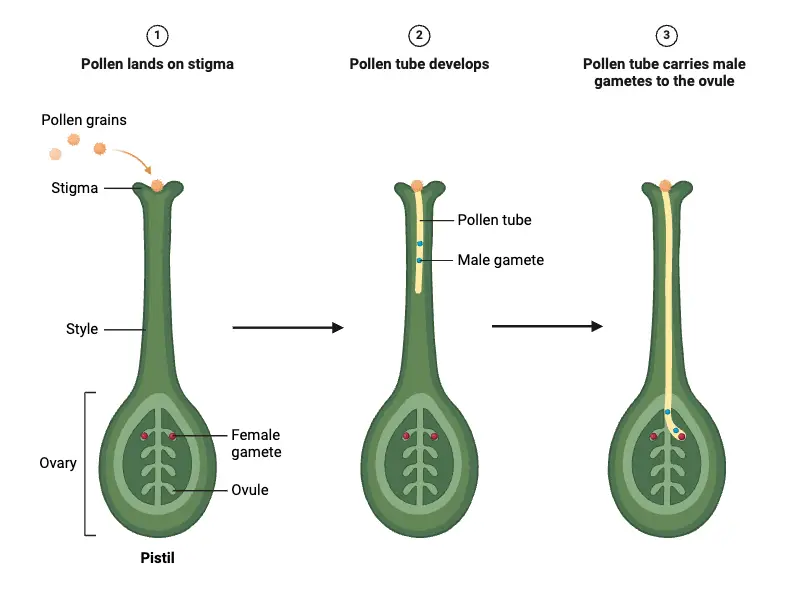
Pollination in Angiosperms
Pollination in angiosperms (flowering plants) is a crucial process for sexual reproduction, involving the transfer of pollen grains from one flower to another. This process can be categorized into two primary types: self-pollination and cross-pollination.
- Types of Pollination
- Self-Pollination: This occurs when pollen grains from the same flower or the same plant fertilize the ovules. Self-pollination ensures that a plant can reproduce even in the absence of pollinators or when other plants are not nearby. This mechanism is common in flowers with structures that facilitate direct pollen transfer within the same flower or between flowers on the same plant.
- Mechanisms: Structures such as the anther and stigma are adapted to bring pollen into contact with the ovules of the same flower.
- Advantages: This form of pollination guarantees fertilization, which is beneficial in stable environments where genetic variation is less critical.
- Cross-Pollination: This involves the transfer of pollen from the flower of one plant to the stigma of a flower on a different plant of the same species. Cross-pollination promotes genetic diversity within plant populations, enhancing their adaptability and resilience.
- Agents of Pollination: Cross-pollination typically relies on biotic agents such as insects (e.g., bees, butterflies), birds (e.g., hummingbirds), and sometimes abiotic agents like wind or water. Each agent has evolved to interact with specific floral structures and ensure effective pollen transfer.
- Benefits: Increased genetic variation helps plants adapt to changing environmental conditions and resist diseases.
- Self-Pollination: This occurs when pollen grains from the same flower or the same plant fertilize the ovules. Self-pollination ensures that a plant can reproduce even in the absence of pollinators or when other plants are not nearby. This mechanism is common in flowers with structures that facilitate direct pollen transfer within the same flower or between flowers on the same plant.
- Pollination Structures and Adaptations
- Pollen Grain Structure: Pollen grains are produced in the anthers of flowering plants. They can exhibit various forms depending on the plant species.
- Tetrads and Compound Pollen Grains: In some angiosperms, pollen grains remain aggregated in groups known as tetrads. These can form compound pollen grains, which are more common in certain plant species.
- Variability: For instance, rose pollen grains are typically fine and yellow, adaptable for wind or animal-mediated transfer, while hibiscus pollen grains are larger (80–180 µm in diameter) and spherical, suited for specific pollination strategies.
- Pollen Grain Adaptations: The physical characteristics of pollen grains, such as size and shape, vary between species and are adapted to their pollination mechanisms.
- Rose Pollen: Fine and elliptical, facilitates wind and animal transfer.
- Hibiscus Pollen: Larger and spherical, adapted for different pollination mechanisms and environmental conditions.
- Pollen Grain Structure: Pollen grains are produced in the anthers of flowering plants. They can exhibit various forms depending on the plant species.
- Ecological and Evolutionary Implications
- Ecological Role: Pollination supports the reproduction of flowering plants, maintaining plant populations and ecosystems. Pollinators play a vital role in this process, and their health directly impacts plant reproduction and biodiversity.
- Evolutionary Adaptations: Plants and pollinators have co-evolved, with flowering plants developing traits that attract specific pollinators. These adaptations ensure effective pollen transfer and successful reproduction.
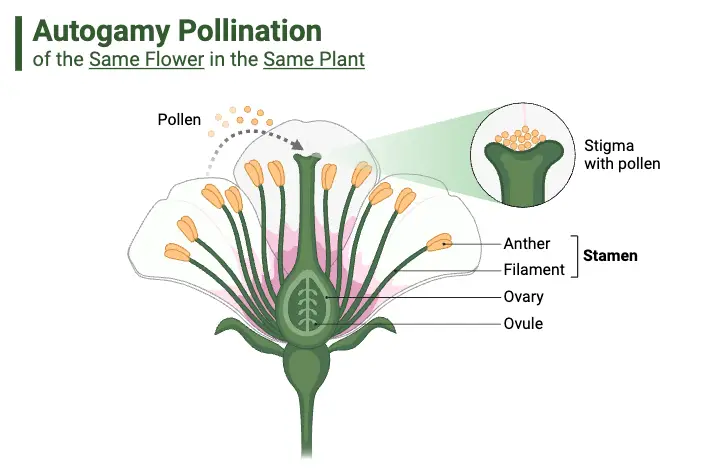
Pollination in Gymnosperms
Pollination in gymnosperms, a group of seed-producing plants that includes conifers, cycads, ginkgoes, and gnetophytes, involves a distinct set of processes and structures. Unlike angiosperms, gymnosperms do not produce flowers; instead, they rely on cones and other mechanisms to achieve pollination.
- Pollen Production and Transfer
- Microsporangia: Pollen grains are produced in the microsporangia of gymnosperms, which are located within the male cones. These structures are responsible for the generation of male gametes (sperm cells) necessary for fertilization.
- Pollination Process: Pollen grains from the male cone are transferred to the female cone, which houses the ovules (female gametes). This transfer is essential for fertilization to occur.
- Germination and Pollen Tube Formation: Once the pollen grain reaches the female cone, it germinates, forming a pollen tube. This tube grows through the female cone to deliver the sperm cells to the ovule for fertilization.
- Modes of Pollen Transfer
- Wind Pollination: Gymnosperms predominantly rely on wind for pollen transfer. This method is efficient for these plants as cones are not typically visited by animals or insects, primarily due to the absence of nectar.
- Adaptations for Wind Pollination: The structure of gymnosperm pollen grains often includes air sacs or vesicles, such as sacci, which aid in the dispersal of pollen by wind. For example, the pollen grains of the Pinus species feature two sacci that facilitate their airborne movement.
- Water Pollination: In some gymnosperms, such as certain conifers, water can also play a role in transferring pollen. Rain can carry pollen grains to the female cones, although this is less common than wind pollination.
- Wind Pollination: Gymnosperms predominantly rely on wind for pollen transfer. This method is efficient for these plants as cones are not typically visited by animals or insects, primarily due to the absence of nectar.
- Pollen Grain Structure
- Sac Structures: Gymnosperm pollen grains typically possess sac-like structures called sacci. These sacci are crucial for their adaptation to wind pollination. They help the pollen grains remain airborne longer and increase the likelihood of reaching female cones.
- Pinus Pollen: An example of this adaptation is observed in Pinus pollen grains, which contain two sacci that enhance their dispersal capabilities.
- Sac Structures: Gymnosperm pollen grains typically possess sac-like structures called sacci. These sacci are crucial for their adaptation to wind pollination. They help the pollen grains remain airborne longer and increase the likelihood of reaching female cones.
- Pollination in Specific Gymnosperms
- Conifers: Most gymnosperms are conifers, such as pines and spruces, which utilize wind pollination. Their cones are specialized for this process, with male cones producing large quantities of pollen that are dispersed by the wind.
- Ginkgo and Cycads: Some gymnosperms, like ginkgo and cycads, may secrete a pollination fluid to attract specific pollinators. Although these plants are primarily wind-pollinated, the pollination fluid can assist in the transfer of pollen from male to female cones.
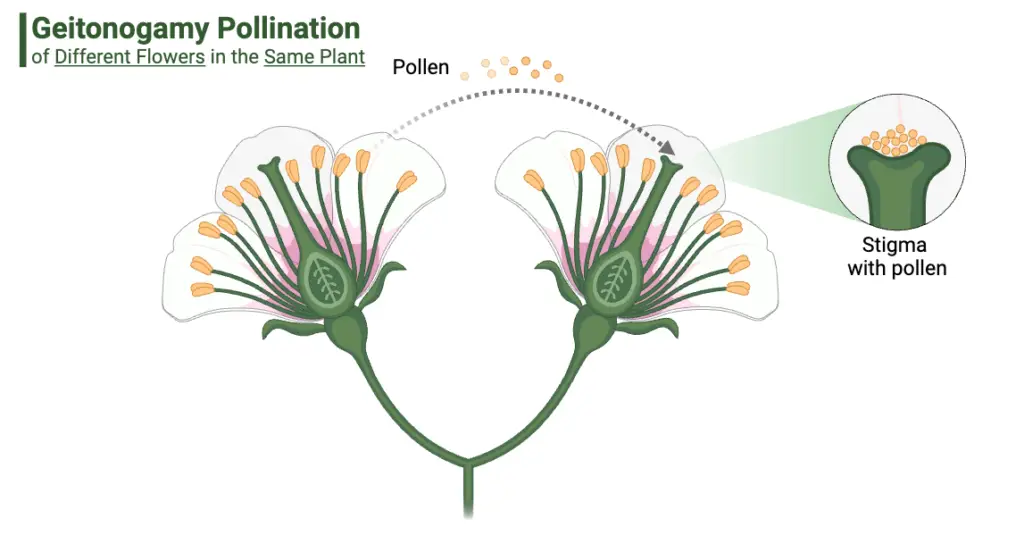
Function of Pollen Grains
Pollen grains, often perceived as mere yellow dust, play a crucial role in the reproductive processes of plants. This microscopic structure is integral to the continuation of plant species and exhibits multiple functions:
- Reproductive Role in Plants
- Transfer of Male Gametes: Pollen grains are the carriers of male gametes (sperm cells) in both gymnosperms (cone-bearing plants) and angiosperms (flowering plants). Their primary function is to transfer these male gametes to the ovule, which contains the female gametes, within the ovary of the flower. This transfer is essential for fertilization, leading to the development of seeds.
- Facilitation of Fertilization: Upon successful transfer, the male gametes fuse with the female gametes in the ovule. This process, known as fertilization, results in the formation of seeds, which will eventually germinate into new plants.
- Genetic Diversity
- Maintenance of Genetic Variation: By facilitating cross-pollination, pollen grains help in maintaining genetic diversity within plant populations. Cross-pollination occurs when pollen from one plant fertilizes the ovules of another plant. This genetic mixing is vital for the adaptation and survival of plant species in changing environments.
- Enhanced Adaptability: The genetic variation introduced through cross-pollination contributes to the adaptability of plants, allowing them to better cope with environmental stresses and resist diseases.
- Nutritional Value
- Nutrient-Rich Content: Pollen grains are composed of proteins, carbohydrates, fats, vitamins, and minerals, making them highly nutritious. They are often used in dietary supplements to provide health benefits.
- Food Supplements: Due to their rich nutrient profile, pollen grains are processed into tablets and other supplements. These supplements are believed to support various aspects of human health, although their efficacy can vary.
Cross Word Worksheet on Pollen Grain
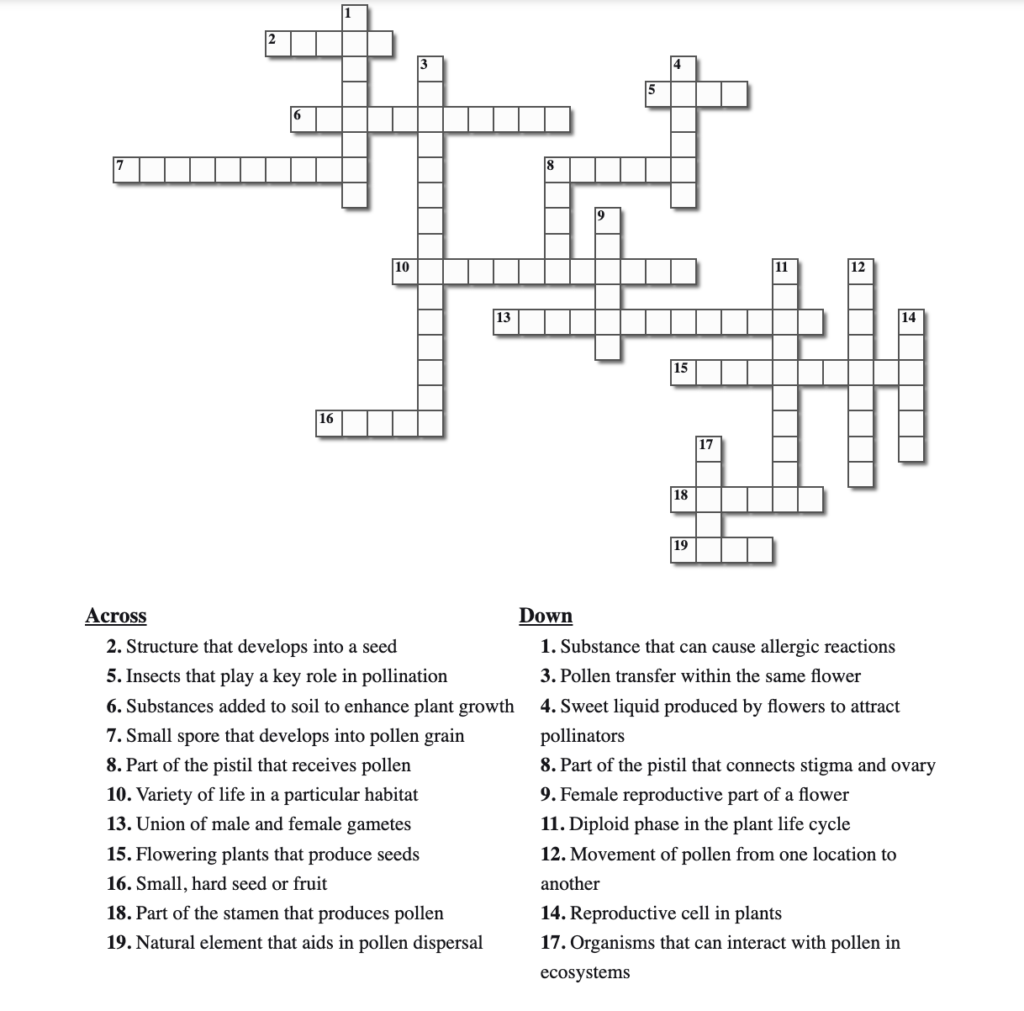
FAQ
What is a pollen grain?
A pollen grain is a microscopic structure produced by seed plants that contains male gametes (sperm cells). It is essential for the reproductive process, enabling the transfer of genetic material to the female gametes in flowers or cones.
What are the primary functions of pollen grains?
Reproduction: Pollen grains facilitate the transfer of male gametes to female gametes for fertilization, leading to seed formation.
Genetic Diversity: By enabling cross-pollination, pollen grains help maintain genetic variation within plant populations.
Nutritional Value: Pollen grains are rich in nutrients and are used in dietary supplements for their health benefits.
How does pollination occur?
Pollination occurs when pollen grains are transferred from the anther of one flower or cone to the stigma of another flower or cone. This can happen through various mechanisms:
Wind Pollination: Pollen is carried by the wind to other flowers or cones.
Animal Pollination: Insects, birds, and other animals transfer pollen while foraging for nectar.
Water Pollination: Water, such as rain, can carry pollen to the reproductive structures of plants.
What is the difference between self-pollination and cross-pollination?
Self-Pollination: Occurs when pollen from the same flower or plant fertilizes its own ovules. It ensures reproduction but limits genetic diversity.
Cross-Pollination: Involves the transfer of pollen from one plant to another plant of the same species, promoting genetic diversity and adaptability.
What are sacci, and what role do they play in pollen grains?
Sacci are small air sacs or vesicles found in the pollen grains of some plants, particularly gymnosperms. They help to keep pollen grains airborne, enhancing their dispersal by wind and increasing the chances of reaching female reproductive structures.
How do pollen grains vary among different plant species?
Pollen grains vary in size, shape, and surface features depending on the plant species:
Size: Pollen grains can range from very small to relatively large.
Shape: They can be spherical, elliptical, or irregularly shaped.
Surface Features: The surface of pollen grains may be smooth, rough, or covered with various patterns and structures.
What are the common methods for studying pollen grains?
Pollen grains can be studied using various techniques:
Microscopy: Light and electron microscopes are used to observe the size, shape, and surface features of pollen grains.
Pollen Analysis: Techniques such as palynology involve examining pollen grains to understand plant diversity and past climates.
Pollen Trap: Devices that collect airborne pollen for analysis of pollen types and concentrations.
Why are pollen grains important to ecosystems?
Pollen grains play a critical role in ecosystems by enabling plant reproduction and supporting food webs. They are a primary food source for many insects and contribute to the diversity and stability of plant communities.
How do pollen grains affect human health?
Allergies: Pollen grains can trigger allergic reactions in some individuals, leading to conditions such as hay fever.
Nutritional Supplements: Pollen grains are used in dietary supplements due to their rich nutrient content, which includes proteins, vitamins, and minerals.
Can pollen grains be preserved?
Yes, pollen grains can be preserved through techniques such as drying and embedding in resin. This preservation allows for the study of historical and ecological changes by analyzing fossilized pollen found in sediment layers.
- https://www.nou.ac.in/econtent/Msc%20Botany%20Paper%20VIII/MSc%20Botany%20Paper-VIII%20Unit-7.pdf
- https://www.uwa.edu.au/study/-/media/Faculties/Science/Docs/What-is-pollen.pdf
- https://www.geeksforgeeks.org/pollen-grains/
- https://www.biologyonline.com/dictionary/pollen-grain
- https://www.pw.live/exams/neet/pollen-grain/
- https://www.beelistener.co.uk/bee-health/pollen-structure-and-function/
- https://www.termedia.pl/Pollen-structure-and-morphology,7,2107,1,1.html
- Text Highlighting: Select any text in the post content to highlight it
- Text Annotation: Select text and add comments with annotations
- Comment Management: Edit or delete your own comments
- Highlight Management: Remove your own highlights
How to use: Simply select any text in the post content above, and you'll see annotation options. Login here or create an account to get started.